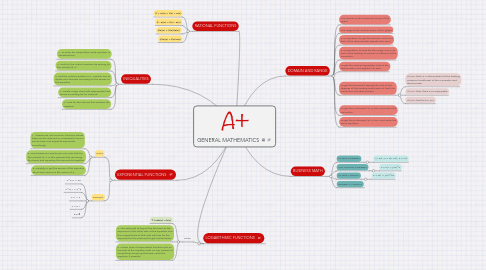
1. EXPONENTIAL FUNCTIONS
1.1. Rules
1.1.1. 1. If bases are not common, find one whose base can be reduced or increased to have a similar base and adjust its exponents accordingly
1.1.2. 2. Once bases are similar, you can now look for the value(s) of 'x' in the exponent by removing the bases and equating the exponents together.
1.1.3. 3. Simplify or get the zeroes of the equation which also serves as the values of 'x'
1.2. Example
1.2.1. 2^x+1 = 32
1.2.2. 2^x+1 = 2^5
1.2.3. x+1 = 5
1.2.4. x = 5-1
1.2.5. x = 4
2. LOGARITHMIC FUNCTIONS
2.1. Rules:
2.1.1. 1. logb(x) = b(x)
2.1.2. 2. The subscript of log will be the base to the exponent in the other side of the equation and the original base of that side will now be the exponent to the subscript to get similar bases
2.1.3. 3. Follow rules of exponential functions but on the side of the equation with no log, instead of completely removing the base, solve the equation if possible
3. RATIONAL FUNCTIONS
3.1. (f + g)(x) = f(x) + g(x)
3.2. (f - g)(x) = f(x) - g(x)
3.3. (fg)(x) = (f(x))(g(x))
3.4. (f/g)(x) = f(x)/g(x)
4. INEQUALITIES
4.1. 1. To solve for inequalities, write equation in standard form
4.2. 2. Look for the critical numbers by solving for the value(s) of 'x'
4.3. 3. Plot the critical numbers in a number line to divide into intervals according to the zeroes of the equation
4.4. 4. Create a sign chart with appropriate test values according tot he intervals
4.5. 5. Look for the interval that satisfies the equation
5. DOMAIN AND RANGE
5.1. The domain is the horizontal scope of the graph.
5.2. The range is the vertical scope of the graph
5.3. In an equation, to get the domain, one must look at the denominator (equate it to zero)
5.4. In an equation, to look for the range, one must look at the leading numerical co-efficient of the numerator
5.5. To get the vertical asymptote, look at the denominator and equate if to zero
5.6. To get the horizontal asymptote, look at the degrees of the leading coefficients of both the numerator and denominator
5.6.1. If n=m, the h.a. is the quotient of the leading numerical coefficient of the numerator and denominator
5.6.2. If n>m, then there is no asymptote
5.6.3. If n<m, the the h.a. is 0
5.7. To get the x-intercept, let 'y' be 0 and solve the numerator
5.8. To get the y-intercept, let 'x' be 0 and solve the entire equation
6. BUSINESS MATH
6.1. SIMPLE INTEREST
6.1.1. I = Prt ; F = P(1+rt) ; P = I/rt
6.2. COMPOUND INTEREST
6.2.1. F = P(1 + j/m)^n
6.3. SIMPLE ANNUITY
6.3.1. F = R(1 = j/m)^tm
